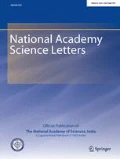Abstract
The study on integrated farming system (IFS) was conducted during 2011–2017 at Agricultural Research Station, Kovilpatti, to find out economic viability of IFS model by changing in crop(s) or cropping system and integrating different livestock enterprises. The IFS model consisted of five crops or cropping systems, viz. sorghum (K-8) + cowpea (Co-7) (1:1) (0.40 ha), maize [CoH (m)-6] + greengram (Co-6) (1:1) (0.15 ha), cotton (KC-3) + blackgram (UBN-6) (1:1) (0.60 ha), clusterbean (local variety) (0.15), fodder crops [sorghum (COFS 29), Deshmanthus (local variety)] (0.30 ha) with dairy (1 cow + 1 calf of Sindi breed) and goatery (10 does + 1 buck of kanni breed) components in 1.60 ha total area. The results indicated that the IFS model is good enough to provide sustained average net income of ` 137,712/ha and employment of 389 man days/year as compared to conventional cropping systems (CCS) which gave average negative net income of ` 644/ha during 6 years of investigation due to deficit of rainfall. Thus, it is concluded that farm productivity and profitability as well as employment generation could be sustained by integrating different enterprises, i.e. dairy and goatery along with modified cropping systems in Southern Zone of Tamil Nadu.


References
CRIDA (2011) Vision 2030. Hyderabad, India, Central Research Institute for Dryland Agriculture, Santoshnagar, p 31
Sasikala V, Tiwari R, Saravanan M (2015) A review on Integrated farming systems. J Int Acad Res Multidiscip 3(7):319–328
Jayanthi C, Mythili S, Balusamy M, Sathivel N, Sankaran N (2003) Integrated nutrient management through residue recycling in low land farming system. Madras Agric J 90(1–3):103–107
AICRPDA (2007) Annual Report. Kovilpatti main centre, All India Coordinate Research Project on Drylands, p 132
Panwar AS, Ravisankar N, Shamim M, Prusty AK (2018) Integrated farming systems: a viable option for doubling farm income of small and marginal farmers. Bull Indian Soc Soil Sci 32:68–88
Reddy MD (2005) Predominant farming systems and alternatives in Andhra Pradesh. Alternative Farming systems In: Singh, AM, Gangwar, B, Sharma, SK (Eds.) Farming Systems Research and Development Association, Modipuram, pp. 217–227
TAR-IVLP, (2003) Technology Assessment and Refinement through InstituteVillage Linkage Program in Eastern Dry Zone in Karnataka. IIHR, Bangalore, Karnataka, pp 12–16
Rangasamy A, Venkitasamy R, Jayanthi C, Purshothaman S, Palaniappan SP (1995) Rice-based farming system: a viable approach. Indian Farming 44(11):27–29
Radhamani S (2001) Sustainable integrated farming system for dryland Vertisol of Western Zone of Tamil Nadu, Ph.D. (diss) Tamil Nadu Agricultural University, Coimbatore, India
Devendra C (1999) Goats: challenges for increased productivity and improved livelihoods. Outlookon Agric 28:215–226
Acknowledgements
The authors are thankful to Director, Central Research Institute for Dryland Agriculture, Hyderabad, India, and Vice Chancellor, TNAU, Coimbatore, for providing all the facilities and financial support for this study and the support for conducting field study and analysis.
Author information
Authors and Affiliations
Corresponding author
Ethics declarations
Conflict of interest
The authors declare that they have no conflict of interest.
Additional information
Publisher's Note
Springer Nature remains neutral with regard to jurisdictional claims in published maps and institutional affiliations.
Significance Statement: Rainfed farming constitute 58% of net sown area contributes 44% of total food grain production, which supports 40% of human and 66% of livestock population. However, abnormal behaviour of rains with resource degradation and poor resource base of farmers in these areas are the main causes for low and unstable crop yields. IFS approach is good enough to provide sustained net income of ` 137712/ha with employment of 389 man days/year as compared to popular crops or cropping systems in Southern Zone of Tamil Nadu.
Rights and permissions
About this article
Cite this article
Elamathi, S., Singh, S., Rangaraj, T. et al. Integrated Farming System Model for Sustained Farm Income and Employment Generation Under Rainfed Vertisol of Southern Zone of Tamil Nadu. Natl. Acad. Sci. Lett. 44, 485–487 (2021). https://doi.org/10.1007/s40009-021-01059-6
Received:
Revised:
Accepted:
Published:
Issue Date:
DOI: https://doi.org/10.1007/s40009-021-01059-6

